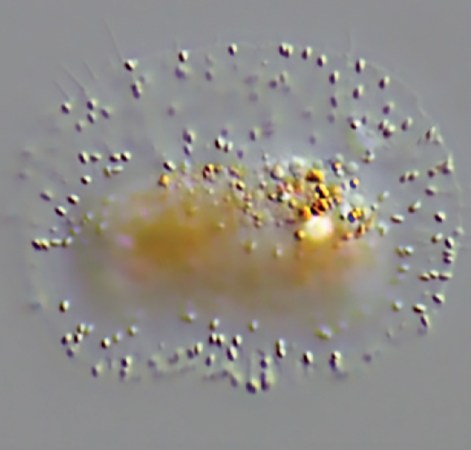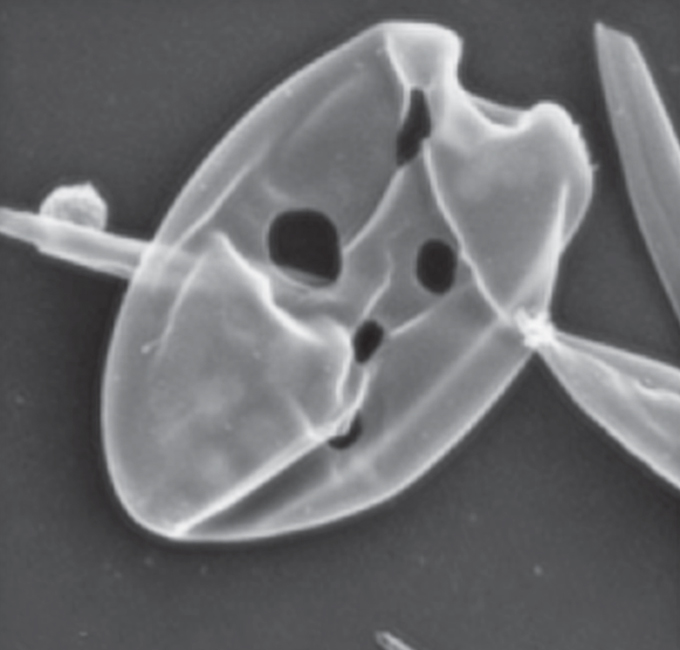What the weird world of protists can teach us about life on Earth
A close-up look at these microbes highlights how much we don't know about life on our planet

This is a microscopic diatom, a type of protist. It has a hard, porous cell wall.
Dennis Kunkel Microscopy/Science Photo Library/Alamy Stock Photo
Gumdrop with an earring.
That’s what pops to mind when I look at photos of a creature Sebastian Hess found in a mossy pond in Germany. It’s kind of plump and has only one cell. It’s also violent.
This shape-shifting, amoeba-like cell prowls for algal cells to attack. It curls a long strand called a flagellum into an earring-like loop. Holding the loop steady, the cell somehow glides. “They look basically like tiny flying saucers,” Hess says.
Hess has been seeking and tending such single-celled wonders since a young age. As a teenager, he kept a zoo of microbes on his windowsill. Now, he’s a biologist at Technical University of Darmstadt in Germany. But he still studies the same type of specimens that filled his zoo: the protists.
Protists are a huge, varied group of one-celled organisms. On the traditional “tree of life,” they comprise a whole kingdom, alongside those for animals, plants, fungi, bacteria and archaea.
Protists are among the closest microbial cousins to multi-celled life. Like animals, plants and fungi, they wrap their genetic material inside a cell nucleus. Yet they’re often overlooked, drawn in many science textbooks as a lower branch beneath the crown of many-celled life.
It’s becoming clear, however, that the small can be mighty. And, they outnumber us — by a lot.
In fact, single-celled microbes — protists among them — dominate the planet. A 2018 comparison estimates that Earth’s protists account for twice as many gigatons of carbon (an ingredient of life) as all animals put together. Add in other microbes, and together they hold 40 times the biomass of animals.
We may think that what we can see represents much of our world’s life. Yet our eyes capture only a narrow — and rather odd — sliver of life’s variety.
As high-tech biology meets old-fashioned boots-in-mud exploration, protists are getting a closer look. What scientists are learning challenges old notions that single cells are simple. The microscopic world is full of breathtaking complexity and diversity.
And the tiny protists are giving us a whole new view of what it means to live on Earth.
We live on a non-animal planet
Hess’ flying saucers are just one of an amazing array of protists. The kingdom showcases a wide variety of looks and behaviors.
Daimonympha, a new species named just last June, has the one-celled equivalent of a rotating head. The cell itself is roughly shaped like a globe. The top, somehow, spins steadily around without ripping or strangling itself.
Emiliania, which lives in the sea, covers its cell in what look like tiny hubcaps. Another group of water-dwellers, Euplotes, grows skinny projections that look like stick-drawing legs. Even with no brain or nervous system, some of these cells can “walk” on an underwater surface. (Engineers seeking inspiration for microscale robots have been analyzing such gaits.)
“Stunning” is how Hess describes protists. “They really behave like entire organisms,” he says. “But they are just cells.”
Many are fierce predators. One of his favorites has a pretty teardrop shape. But don’t let Lacrymaria’s mild looks deceive you. This cell chases prey by shooting out a cartoonishly long swan neck. It can stretch more than seven times the length of the original cell. That neck swerves this way and that, lithe as a snake — until a sudden pounce finally snags dinner.
Or consider five new species of tiny, voracious cells nicknamed nibblerids. When hungry, they take a sickle shape that measures just 3 micrometer (a 10-thousandth of an inch) across. They typically feast on larger victims, “biting” down on them with a special body groove. It’s armored with hard, toothlike bits called denticles.
Hess’ flying saucers are amoebas called Idionectes. They use a stealthier approach. When one spots an algal meal, the gliding spaceship becomes an attack amoeba. First, it dissolves a hole through the algal cell’s wall. Then it slides itself through the hole and devours its prey from the inside.
Predators play critical roles in their ecosystems, says Patrick Keeling. He’s an evolutionary biologist at the University of British Columbia in Vancouver, Canada. As an example, think of animal-based food chains. “If you took all the lions and cheetahs and killed them all,” he says, “the whole ecosystem would go wacky.” That’s likely the case with protists, too.
Just be glad that protists aren’t bigger. Or that humans aren’t smaller.
Do you have a science question? We can help!
Submit your question here, and we might answer it an upcoming issue of Science News Explores
Microbes experience a different world
Protists’ tiny size means that they inhabit a different version of the world than we do.
“We spend so much time trying to imagine alien worlds,” says Keeling. “There’s one right under our noses — more weird than anything we can think of.”
Consider how protists’ bodies experience water. Lone cells are so tiny that the properties of plain water affect them very differently than they do humans and other sizable swimmers.
Say you dive into a swimming pool. “If you’re not kicking, you still go forwards for quite a while until you stop, right?” Keeling asks. For a single cell, though, the viscosity of water means the cell barely glides at all. If it stops swimming, it just … stops. “It’s more like you’re in corn syrup,” he says.
This “syrup world” changes how critters have to approach swimming.
Think about a sea scallop. Normally, it opens its shell slowly and snaps it closed to jet around. But if it were magically miniaturized, the scallop would be stuck flapping in place. Physicists predict it could move by shutting its shell, but would slip right back upon opening it again.
On the upside, though, motions that are useless for people or scallops could propel a tiny swimmer. Physicist Geoffrey Ingram Taylor theorized one idea in 1952. Take a microbial swimmer shaped like a doughnut, he said. It should be able to move itself with a sort of inward rotation.
In fact, that rotation is more or less how Idionectes swims with its loop. Hess and colleagues announced that in 2019, nearly 70 years after Taylor’s suggestion. The cell’s long, stringy flagellum curls into a skimpy “doughnut” shape. At first, Hess couldn’t see it moving at all. Then he and his colleagues put those cells in a syrupy fluid full of bits of latex. Movements of the microparticles showed the loop was rotating after all.
How protists are discovered
This wild world of protists really is right under our noses — and everywhere.
In 2016, Kiran More was an undergraduate at Dalhousie University in Halifax, Canada. That summer, his family drove through the eastern countryside of Nova Scotia. At a village on Cape Breton Island, More scooped up some sand from the shore. He had packed a set of sampling tubes just in case, hoping to search for some new species. “I just carried it from hotel room to hotel room and stuck it in the minifridge,” he says.
He brought the sand back to school where it became part of his undergraduate research project. He was looking for unknown species of marine amoebas called vampyrellids.
The name sounds spookier than they look. Some look a bit like fried eggs. But a vampyrellid’s “egg white” is actually an attack structure. It can pierce algal cells to feast on their nutritious interior.
In his sand, More found at least seven different vampyrellid amoebas. Two fried-egg types turned out to be new species. Now named Placopus melkoniani and P. pusillus, they hunt by rolling forward. Their outer membranes move “like a conveyor belt,” More says — or maybe the treads on a tank. “You can see all their cell contents inside also rotating as the outer membrane rotates, which is almost beautiful,” he says.
In 2021, he described a third new species from that same vacation sand. More was then a graduate student at the University of Alberta in Edmonton, Canada. He was part of a team that named this species Sericomyxa perlucida. This means “transparent silken slime.” It looks like a road-killed badminton shuttlecock, but with exquisitely delicate tufts. And it was not just a new species in a new genus but also a whole new family of protists.
Microbes dominate Earth
Protists may seem weird. But in many ways, we are actually weirder, says Maureen O’Malley. As multicellular beings, she says, “we’re an aberration.” She’s a philosopher of microbiology at the University of Sydney in Australia.
Earth housed only microbes for more than half its existence — 2.5 billion years or more, O’Malley points out. Multicellular life was able to evolve due to microbial innovations. One example: the oxygen we breathe. It was produced by cyanobacteria via photosynthesis, starting 2.7 billion years ago.

Even today, an estimated half of the oxygen we breathe comes from microbes, not plants. And plants got their own oxygen-making ability from microbes, too. Plant chloroplasts, where photosynthesis takes place, arose from microbes once engulfed by plant ancestors.
Protists help plants and animals in countless other ways every day. Termites “eat” wood thanks to the protists packed into their guts. Tomato plants grow better with more predatory protists in the soil around their roots. The list goes on and on. Protists and other microbes shaped the world and keep us alive in it.
O’Malley sums up microbes as “the dominant life-forms not only in today’s world, but also in all past eras of the living Earth.”
With a few quirky exceptions — including us — to be an earthling is to be microscopic.









